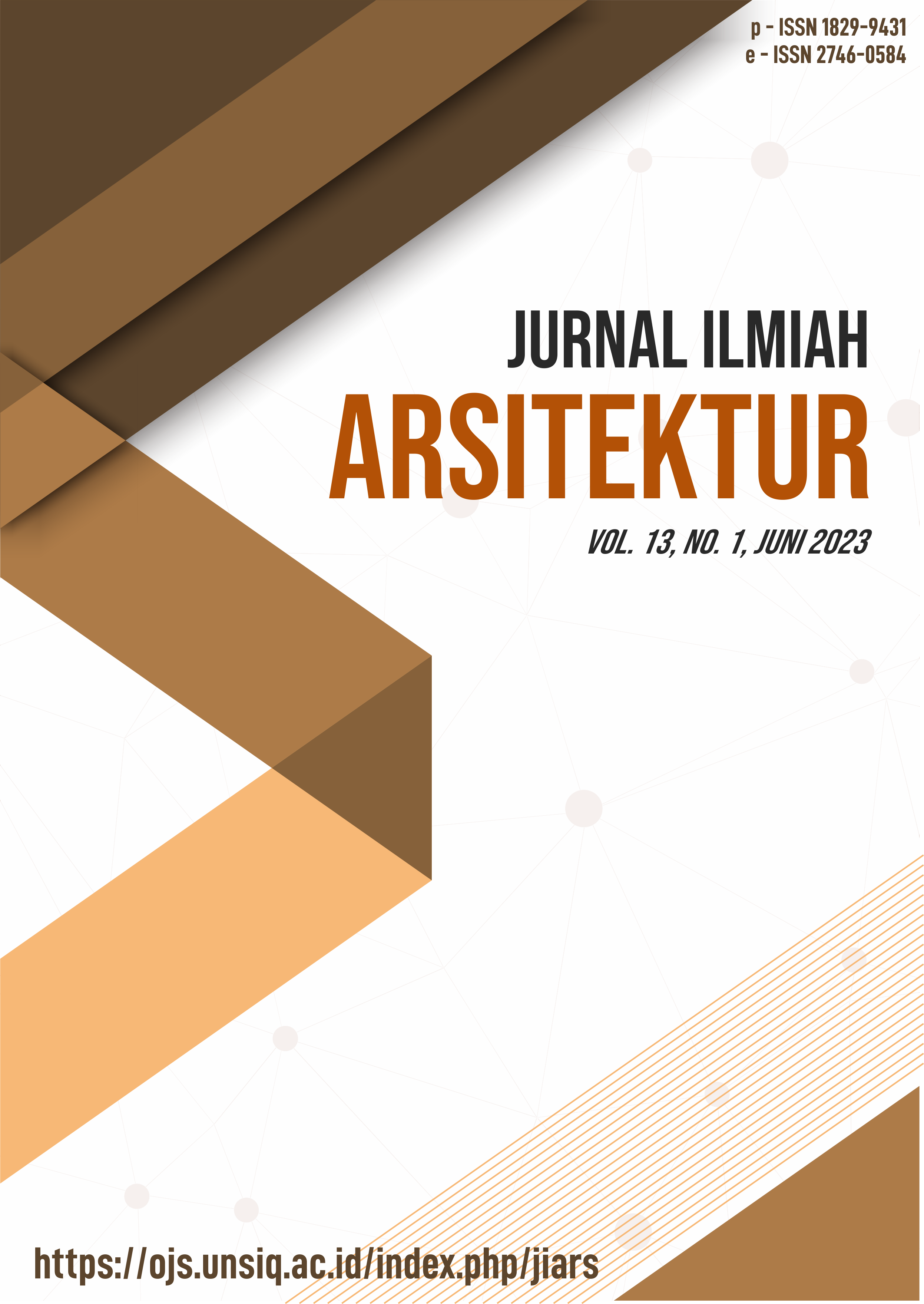PERAPIAN DAN SPASIAL ARSITEKTUR PADA HUNIAN
DOI:
https://doi.org/10.32699/jiars.v13i1.6277Keywords:
Karakter spasial, vernakularisme, perapianAbstract
Arsitektur mempunyai kaitan dengan segala aspek dan banyak bidang ilmu. Salah satu aspek kehidupan yang menjadi dasar dalam arsitektur yaitu api. Teori api dan arsitektur telah lama ditemukan dan banyak unsur dalam arsitektur yang dipengaruhi oleh api. Teori api dan arsitektur tidak lepas dari aspek budaya dan interaksi sosial. Tujuan penelitian adalah menggali aspek perwujudan dari api dalam aspek atau unsur arsitektur. Metode penelitian menggunakan metode deskripsi dengan menggunakan literatur tentang aspek arsitektur khususnya tiga aspek yaitu karakter spasial, vernakularisme dan organisasi ruang. Ketiga aspel arsitektur digali dengan berawal dari teori api dan arsitektur. Hasil penelitian menunjukkan bahwa karakter spasial, vernakularisme dan organisasi ruang saling terkaitan dengan adanya teori bahwa api sebagai pusat akvitas. Perwujudan api dan arsitektur terwujud dalam pola yang dibentuk oleh vernakularisme. Sebagian besar penggunaan api sebagai wujud dalam memperoleh kenyamanan termal pada daerah dingin.
References
Al-Hussayen, M. A. (1999), Spatial Characteristics of Traditional Houses of Al-Medinah, Saudi Arabia, Architectural Science Review, 42(4):271-282, DOI: 10.1080/00038628.1999.9697429
Alitajer, S., and Nojoumi, G. M. (2016), Privacy at Home: Analysis of Behavioral Patterns in The Spatial Configuration of Traditional and Modern Houses in The City of Hamedan Based on The Notion Of Space Syntax, Frontiers of Architectural Research 2016(5):341–352
Arredondo-Garrido, D. (2016), References in Le Corbusier’s Reorganization of Rural Habitat, Journal of Architecture and Urbanism, 40(2):99-109, DOI: 10.3846/20297955.2016.1183531
Avermaete, T. (2018), The Socius of Architecture: Spatialising the Social and Socialising the Spatial, The Journal of Architecture, 23(4):537-542, DOI:10.1080/13602365.2018.1479353
Bienkowski, P. and Chlebik, B. (1991), Changing Places: Architecture and Spatial Organization of the Bedul in Petra, Levant, 23(1):147-180, DOI: 10.1179/lev.1991.23.1.147
Chitrakar, R. M., Baker, D. C. and Guaralda, M. (2017), Changing Provision and Use of Neighbourhood Public Space in Nepal’s Kathmandu Valley, Journal of Architecture and Urbanism, 41(1):46-59, DOI: 10.3846/20297955.2017.1296794
Derbyshire, A. and Kecojevic, T. (2014), The Boka Kotorska: A Vernacular Response to Sustainable Urban Environments, Journal of Architecture and Urbanism, 38(2):148-160, DOI: 10.3846/20297955.2014.925630
Dringelis, L., Ramanauskas, E., Povilaitienė, I. and Mačiukėnaitė, J. (2015), Exploration and Respectation of The Spatial Structure of Cities, Towns, Townships and Villages as a Significant Formant of Their Identity, Journal of Architecture and Urbanism, 39(1):79-100, DOI: 10.3846/20297955.2015.1028509
Esfandiari, M, Zaid, S. M. and Ismail, M. A., (2017), Investigating the Indoor Environment Quality Parameters and Their Relationship with Occupants’ Satisfaction in Office Buildings: A Review, Journal of Design and Built Environment, 2017(Special Issue):181-194
Farahani, L. M. and Lozanovska, M. (2015), The Social Life of Historical Neighbourhoods: Case Study of A Middle Eastern City, Shiraz, Journal of Architecture and Urbanism, 39(3):176-187, DOI: 10.3846/20297955.2015.1088416
Horyn, G., Major, Z., Müllner, P. and Benko, M. (2016), Exploration of Spatial Design Issues at Backpacker Hostels in Budapest's Historic Center: Informality, Density, and Adaptability, Frontiers of Architectural Research 2017(6):157–168
Hwang, I. H. and Jeon, J. Y. (2015), Spatiality of Two Urban Religious Spaces in Seoul: A Case Study of Myeong-dong Cathedral and Bongeun Buddhist Temple Precincts, Journal of Asian Architecture and Building Engineering JAABE, 14(3):625-632
Lee, J.H., Ostwald, M. J., and Gu, N. (2015), A Syntactical and Grammatical Approach to Architectural Configuration, Analysis and Generation, Architectural Science Review, 58(3):189-204, DOI:10.1080/00038628.2015.1015948
Lee, S., Ha, J. and Cho, H. (2017), Spatial and Temporal Effects of Built Environment on Urban Air Temperature in Seoul City, Korea: An Application of Spatial Regression Models, Journal of Asian Architecture and Building Engineering JAABE, 16(1):123-130
Lim, H. and Kim, S. (2009), Changes in Spatial Organization in French Public Libraries, Journal of Asian Architecture and Building Engineering JAABE, 8(2):323-330
Megahed, N.A. (2016), Understanding Kinetic Architecture: Typology, Classification, and Design Strategy, Architectural Engineering and Design Management, DOI: 10.1080/17452007.2016.1203676
Park, J-M. (2016), Spatial Configuration Analysis on Three Korean Traditional Dwellings Using the Graph Theory, Journal of Asian Architecture and Building Engineering JAABE, 15(1):103-110
Stalder, L. (2017), ‘New Brutalism’, ‘Topology’ and ‘Image’: Some Remarks on the Architectural Debates in England Around 1950, The Journal of Architecture, 22(5):949-967, DOI: 10.1080/13602365.2017.1351781
Tanaka, M., Kikuchi, Y. and Funo, S. (2002), Spatial Characteristics of House Unit and Role of Shared Chan at Chitlada State Railway of Thailand Housing Site in Bangkok, Journal of Asian Architecture and Building Engineering JAABE, 1(2):185-191
Tuztaşı, U. and Koç, P. (2017), Transformation of Sivas City Center in the Context of Spatial Continuity and Cultural Patterns, Prostor, 25(1):113-127
Watanabe, S. and Masuya, Y. (2013), Spatial Cognition and Intentional Behaviors in the Post-Sedentary Age, Journal of Asian Architecture and Building Engineering JAABE 12(2):285-291
Wulandari, D. W. and Mori, S. (2014), Characteristics of the Spatial Structure of Kosts Private Rental Housing: A Case Study of the Urban Settlement of Jakarta, Indonesia, Journal of Asian Architecture and Building Engineering JAABE, 13(2):309-316
Zhang, Y. and Wei, T. (2017), Typology of Religious Spaces in the Urban Historical Area of Lhasa, Tibet, Frontiers of Architectural Research 2017(6):384-40


